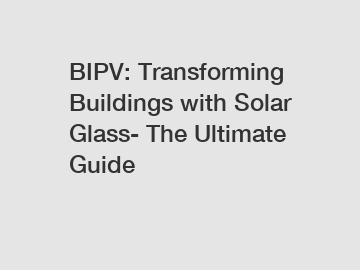BIPV: Transforming Buildings with Solar Glass- The Ultimate Guide
BIPV: Transforming Buildings with Solar Glass- The Ultimate Guide.
Have you ever imagined a world where buildings can harness the power of the sun to generate electricity? Well, that future is now possible with Building Integrated Photovoltaics (BIPV). BIPV has gained significant momentum in recent years, revolutionizing the way we think about solar energy and building design. In this ultimate guide, we will explore the multifaceted world of BIPV, its technology, benefits, and potential for transforming our built environment.
Building Integrated Photovoltaics, or BIPV, is a cutting-edge technology that integrates solar cells directly into building materials. This means that the surfaces of a building, such as windows, walls, and even roofs, can become active solar generators. Unlike traditional solar panels mounted on rooftops, BIPV seamlessly blends with the structure's architecture, creating a visually appealing and energy-efficient design.

The Technology Behind BIPV.
BIPV technology relies on thin-film solar cells, which are flexible and can be seamlessly integrated into various building materials. These solar cells are designed to convert sunlight into electricity, just like conventional solar panels. The key difference lies in their ability to replace traditional building materials like glass, concrete, or roofing materials. By incorporating solar cells into these materials, BIPV transforms buildings into energy-generating powerhouses.
Types of BIPV Systems.
BIPV systems come in various forms, each designed to meet the specific needs of different building elements. Here are some common types:
1. Solar glass windows: Ordinary windows are replaced with solar glass, allowing them to generate electricity while still providing transparency.
2. Solar roof tiles: BIPV roof tiles are designed to replace traditional roof tiles, providing both weather protection and solar power generation.
3. Solar facades: Entire building facades can be clad with solar panels, transforming them into aesthetic and functional energy generators.
Benefits of BIPV.
The adoption of BIPV offers a range of benefits, making it an attractive choice for building owners, architects, and developers:
1. Energy efficiency: BIPV systems allow buildings to generate their own clean energy, reducing reliance on fossil fuels and lowering electricity bills.
2. Sustainability: By utilizing renewable energy sources, BIPV helps reduce carbon emissions, mitigate climate change, and create a more sustainable built environment.
3. Aesthetics: Unlike traditional solar panels, BIPV systems integrate seamlessly into building designs, enhancing their aesthetic appeal rather than compromising it.
4. Resource utilization: BIPV optimizes the use of space by turning previously passive building components into active energy generators, maximizing the return on investment.
5. Noise reduction: BIPV systems can act as sound barriers, lowering noise pollution in urban areas and improving the overall comfort of the building.
6. Longevity and reliability: BIPV materials are designed to withstand harsh weather conditions, ensuring durability and long-term power generation.
Challenges and Future Developments.
Although BIPV holds immense promise, it still faces some challenges that need to be addressed for wider adoption. Cost is a significant concern, as BIPV systems tend to be more expensive upfront compared to traditional building materials. However, decreasing installation and manufacturing costs, along with increased demand, are expected to drive prices down over time.
Another challenge lies in optimizing the efficiency of BIPV systems. While traditional solar panels can be tilted and positioned to maximize sunlight exposure, BIPV materials must balance aesthetics and their sun-soaking potential. Developing more efficient solar cells and improving their integration into building materials will be crucial moving forward.
Despite these challenges, the future of BIPV looks promising. Researchers and innovators are constantly pushing the boundaries of solar cell technology and exploring new materials for integration. As BIPV continues to evolve, we can envision a built environment where every surface harnesses the sun's energy, transforming our cities into sustainable, self-powering ecosystems.
Conclusion.
Building Integrated Photovoltaics (BIPV) is revolutionizing the construction industry by integrating solar cells directly into building materials. This transformative technology offers a plethora of benefits, including energy efficiency, sustainability, aesthetic appeal, and resource optimization. Although challenges remain, BIPV is poised to play a significant role in our journey toward a greener and more resilient future.
When it comes to transforming our built environment, BIPV is not just a fad but a game-changer. Embracing this technology allows us to marry design with functionality, creating buildings that generate clean energy while seamlessly blending into the architectural landscape. As BIPV continues to advance and become more affordable, we can look forward to a world where solar-powered structures are the norm rather than the exception.
References:
1. Green, M. Building integrated photovoltaics (BIPV): A review. Renewable and Sustainable Energy Reviews. 15, 2011, 5447-5463.
2. Mani, M., & Pillai, R. Building integrated photovoltaic systems: A review. Renewable and Sustainable Energy Reviews. 14, 2010, 312-320.
If you are looking for more details, kindly visit solar roof tiles, pv solar parking, integrated solar roof tiles.

Comments